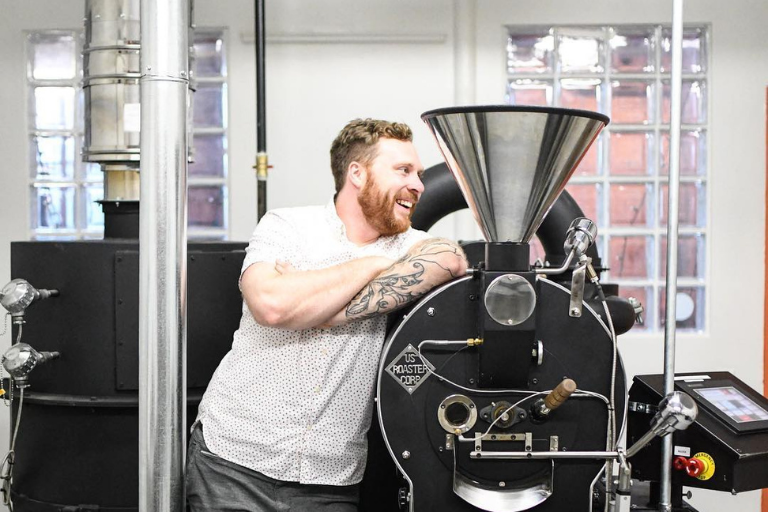Coffee Roasting: A Quick Overview of the Process and Fun Facts
By Tyler Workman

Coffee roasting is a process that we may often take for granted, but it is actually a remarkable union between science and craftsmanship. There is an incredible amount of science behind the roasting process—from understanding the moisture content of the green beans, to monitoring the changes of temperature and airflow in the machine, to being aware of the chemical reactions that occur in the coffee beans during the roasting process. Coffee roasting requires a great deal of craftsmanship because of the many factors that a roaster needs to take into account as well as the unique insight the roaster develops over time about the machine and how it behaves across many variables. Experience allows a roaster to adapt to those variables, exploring the potential of the beans.
It is during the roasting process that the roaster aims to bring to the surface the hidden aromas, flavors, and complexity of that wonderful bean that farmers put so much effort into growing. I don’t intend to provide an in-depth study on coffee roasting through this blog, but rather a general overview of the process while highlighting some fun facts that make this process so unique.

Did you know that what we actually roast is the seed of the coffee fruit (or coffee cherry), which is what we call the coffee bean? Technically, what we are drinking is roasted seeds that previously went through a drying process at the farms they came from (referred to as “green coffee” before the roasting begins). During roasting, the physical characteristics of the beans will change, while the chemical reactions inside transform the beans into a new product that tastes nothing like it did before. That’s right—green coffee tastes and smells nothing like roasted coffee. We are all familiar with the smell of roasted coffee, but did you know that green coffee smells grassy and isn’t very appetizing? It is said that during the roasting process, there are hundreds of aroma compounds developed—this is what makes up the flavor of the coffee.
To understand coffee roasting, the process can be divided into three main stages: the drying stage, the browning stage, and the development stage.
The Drying Stage
When the coffee beans arrive to the roaster, they have a 9–12% moisture content, which is achieved through a variety of ways at the coffee farms from which the beans came. During the drying stage of the roast, most of this moisture is evaporated as the coffee beans begin absorbing heat. This initial step of the roasting process requires a good amount of energy to vaporize the water from inside the beans. A visual characteristic of this stage is the yellowing of the coffee beans.
The Browning Stage
In terms of physical changes, the most visually evident one is the change of color from that yellowish hay hue to a light brown hue—hence why it is a called the “browning stage.” Another change in the beans that is easy to see is the expansion of the beans. As the temperature inside the roaster rises, the transformation of water into gas produces high levels of pressure in the beans. This internal pressure pushes outwards, increasing the volume of the beans while decreasing their mass.
If you decide to get deeper into “roasting theory”—and yes, that is an actual term that we learn when we study coffee roasting—you will come across something called the “Maillard reaction.” This reaction, in very simple terms, describes the formation of complex flavors and aromatic compounds in the beans through chemical reactions between sugars and amino acids found inside them. The reaction is named after the French chemist who discovered it: Louis-Camille Maillard.
The Development Stage
The beginning of the development stage is characterized by “first crack,” which refers to the crackling sound that coffee beans make. That’s right—coffee beans do crackle during the roasting process. This is often compared to the popping sound that popcorn makes, but it is much quieter and less explosive, resembling more of a crackling fire sound. For a roaster, it is very important to pay attention to this sound, as it indicates the starting point of this phase in the roasting process.
During the development stage, sugars in the coffee begin to caramelize, and the amount of time the beans are roasted after first crack directly impacts the acidity, sweetness, balance, and body of the final product. There are two main objectives that lead the roaster through this phase. First is the type of roast the roaster wants to achieve for the coffee. The darker the roast level, the more time the coffee will spend in the machine after first crack. Second is the characteristics of the coffee that the roaster would like to emphasize. For example, a short development time will produce more acidity and vibrancy in the cup. In contrast, a long development time will accentuate sweetness and body in the coffee. In many ways, this stage is where the roaster can get creative and can infuse the roast with a personal touch.
As you can see, there are numerous fascinating details that go into the roasting process, which is what makes this area of coffee so captivating and fulfilling for me. Like with anything in life, the more you do it, the better you get at it, and I can honestly say that I am a more skillful roaster today than I was when I started this coffee journey. Yet, I can also say without a doubt that every time I get my hands on the green coffee, I still approach the roasting process with the same intentionality and singular goal in mind: to unlock the full potential of each and every bean!


0 comments